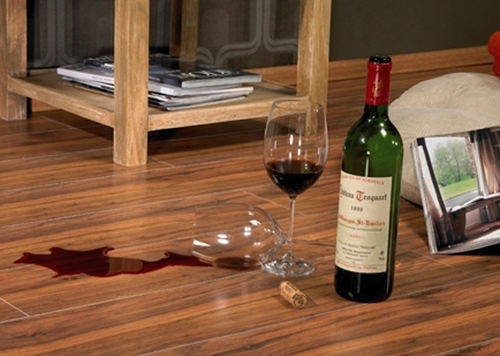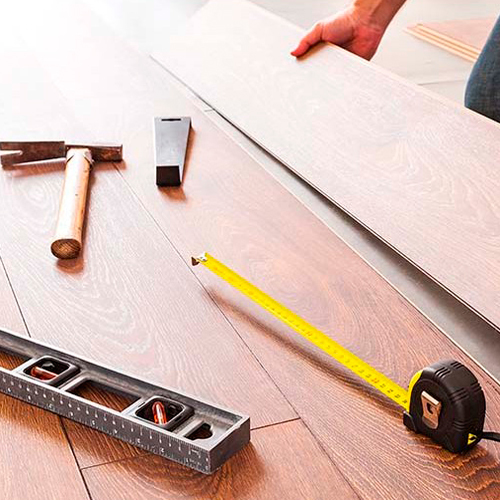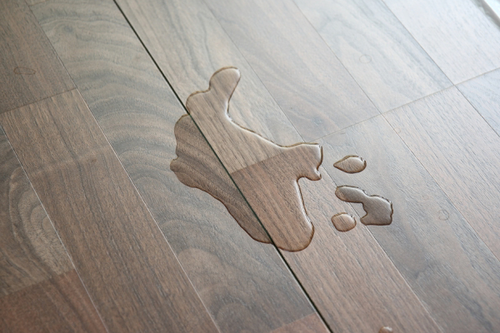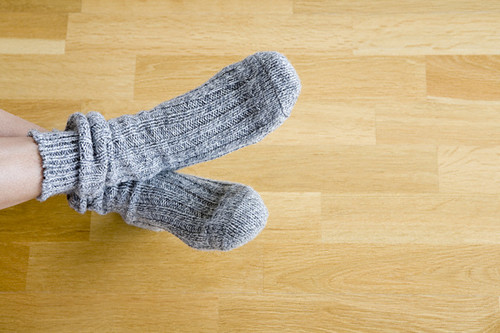
In the modern construction market laminate is one of the most popular floor coverings.
But besides the obvious advantages, it also has disadvantages that should be taken into account by those who are planning a repair. In the worst case, users may experience frustration, and the money for building materials will be wasted. What arguments do not speak in favor of laminate?
Non-natural appearance
Laminate, of course, for the better is different from linoleum. Due to the excellent imitation of stone, wood or other material, the laminate looks very solid and attractive. However, the key word, in this case, is “imitation”. A closer look at the cover, or with the first step taken on it, the fake becomes obvious, and the illusion disappears like smoke. For fans of solidity and natural materials such a nuance is unlikely to taste.
Opinions from the forums:
“At first it was unusual - they walked along the laminate floor, as if by plastic. Parquet or even flooring is much more beautiful and natural. "
“The laminate feels artificial. Barefoot feel unnatural coating, it does not "breathe."
"Pitfalls" installation
Each package of laminate flooring is supplied with instructions that allow even an uninitiated person to repair and construction secrets to make installation independently. Moreover, in the event of an error, it is possible to disassemble the unsuccessful construction and start over. Nevertheless, this seemingly simple procedure conceals a demand, the violation of which can lead to undesirable consequences - from losing the right to guarantee service to undesirable phenomena during operation (squeaks, crackling, damage to the locks). The surface of the base on which the laminate is laid should be dry and perfectly flat. Only a height difference of up to 3 mm per square meter is allowed. It is clear that in the case of laying laminate on a wooden floor or on a scruffy concrete screed, it is rather difficult to fulfill such a condition. Another consequence of the violation of the rules of installation can be bloating (“bubbling”) of the assembled structure, which over time will also lead to breakage.
Opinions from the forums:
"I, apparently, poorly leveled the floor, and in some places at the junction of the plates just locks broke."
“I laid the laminate through the firm. Initially, they made a screed, and then laid. Over time, I noticed that the floor creaks in one place. Immediately did not keep up. I do not even know what to do - the money has already been paid. ”

Photo: techinfus.com
Replacing does not always help
Laminate (especially grades 32 and above) has a fairly reliable and durable protective layer that is resistant to mechanical stress. For a long time he doesn’t care for women's heels, dog claws, children's races on toy cars and other destructive factors. However, gradually this layer also wears out. Alas, it is impossible to polish a new material - it belongs to the category of "disposable". You can replace worn out or lost the appearance of the panel, but to use this technology is not always possible or advisable (for example, due to the lack of commercially available laminate colors). In such cases, the owners most often completely change the entire coverage.
Opinions from the forums:
“Parquet is easier to repair — it was ground and varnished, and the laminate needed to be changed ...”
“We have neighbors flooded laminate. Theoretically, it was necessary to replace no more than 1/3 of the floor area. Bought the same number as it was, but it did not fit in shade. I had to change everything. ”
Acoustic discomfort
This is another drawback that linoleum is almost always devoid of, and often wooden flooring. Laminate, even laid on a standard substrate, has a peculiar “drum effect” - it makes a booming sound when walking in stiff shoes or on heels. Also, when laying on an uneven or unprepared surface, laminate plates can often emit an annoying creak while walking. The use of cork material 2-4 mm thick as a base partly helps to avoid such problems. At least, to protect from them the inhabitants of neighboring apartments. But the price rises at times.
Opinions from the forums:
“The neighbors, living on top, are laminated. Their movements in soft slippers cause such a rumble that it is straightforward "ink the light." And if someone, God forbid, runs through or drops something, they hear three floors below. ”
“We have an inexpensive laminate floor in our office space.” It is simply impossible to walk on it, especially on heels, it feels like a herd of horses are jumping. ”
Low moisture resistance
This is perhaps the most significant flaw in cheap laminate. In a residential apartment, liquid always pours onto the floor: tea, beer, water for watering plants are spilled, a rag does not squeeze out when washing the surface, etc. Sources of unwanted moisture on the laminate can be pets. If the protective coating is to a large extent capable of protecting the front face of the laminated board from moisture, then the joints are truly the Achilles heel of this material. Water between the panels can cause deformation (swelling), cracking and destruction.
Opinions from the forums:
“The laminate was flooded with water - the neighbors flooded. In some places already visible swelling at the seams. "
“The laminate is not friendly with moisture at all. A friend's puppy a couple of times made puddles in the hallway, so laminate swelled. I had to change.

The hazard of laminate when heated
From the very beginning of sales, some environmental experts expressed concern about the use of formaldehyde-based compounds in the manufacture of flooring. According to experts, during the operation in the room laminate floor can be a source of harmful substances in the air. Indeed, when heated to a certain temperature, synthetic raw materials of up to 20% of the laminate, especially in the production of the ultrabudget segment, may emit an insignificant amount of such compounds. The remaining 80% of the composition of the laminate - natural wood, which does not pose any danger to humans. Therefore, it is extremely important to use in combination with the system of underfloor heating only special types of laminate.
Opinions from the forums:
“The real yield of“ chemistry ”from the laminate depends more, probably, on the price than on the coating class.”
“Any chemistry stinks, but cheap laminate is definitely poison. The more toxic substances, the cheaper the material, and the more natural, the more expensive. Put an oak board - take care of the health of children! ”
Cold laminate floor
In comparison with parquet or cork, laminate, like linoleum, is a relatively “cold” material. The situation can be slightly corrected by laying a special substrate or a heat insulating base from cork. So, for example, the use of a 2-millimeter isolon provide heat insulation comparable to the properties of insulated thick linoleum. However, this step significantly increases the cost of coverage.
Opinions from the forums:
“It feels like laminate is barely colder than parquet.”
“The aesthetics, of course, the laminate is not bad, but plastic is plastic - it is not very pleasant to walk barefoot, especially in winter. Like a tile without heating! ”

